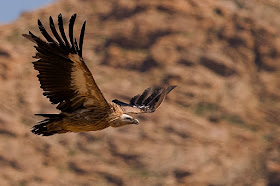Highlights
of 3 weeks lush birding
text & photos (all
vultures from eastern Khangai)
© Andreas Buchheim
The following notes were
taken during a lush-birding trip during which I accompanied Barbara
Pieper and Ludger Pöpel from Germany whereas I myself was
accompanied by my family.
Himalayan Griffon
adult Himalayan Griffon
On 18 June 2011 we drove to
the Baldan Bereiven Monastery in Khentij aimag. On the way we saw
only common birds and we made a brief stop at Khangal nuur. This lake
had been dry for some time but this year there was water and life had
returned. A pair of White-naped Crane was breeding and there were
about 15 pairs of Pied Avocet, sharing a small island with 10 pairs
of Common Tern and a pair of Demoiselle Crane. Although 30
Black-winged Stilts were present as well there were no signs of
breeding. At the monastery, which itself is worth a visit, we only
saw resident birds but it was nice to have a Big-Five-Day with
Bearded Vulture and Eurasian Black Vulture, Eastern Imperial, Golden,
White-tailed and Steppe Eagles all seen from our camp on 19 June
(yes, it is 6 species, but the Big 5 are among them!). On our way
back to the capital we stayed at a large patch of forest which looked
quite promising. But in the evening of 20 June it started raining and
this continued for 40 hours without a break! So we were just
commuting between our tents and the car and did not see any
noteworthy birds. In the end we gave up to wait and on 22 June we
drove back to UB. Because of the rain had caused a flood we had to
take a detour. This brought us to a small dam where three 2cy
Siberian White Cranes were found. This discovery led to the longesttwitch in Mongolia ever.
Eurasian Black Vulture
Eurasian Black Vulture
Of course, we tried our luck
on the Azure-winged Magpies below Songino Khairkhan uul. This time it
was only a matter of minutes until we found them and the same applies
to Azure Tit on 23 June. A Twite was staying at the supposed breeding
site of the magpies as well.
Himalayan Griffon
Himalayan Griffon
The next day we went on and
arrived at Tsagaan nuur, some 200 km west of UB. Wader migration had
commenced as shown by a flock of Northern Lapwing (accompanied by 2
Common Starlings on 25th), a Broad-billed Sandpiper, a Terek
Sandpiper and 160 Wood Sandpipers. Spotted Crakes were calling during
the night.
Himalayan Griffon
Himalayan Griffon
From 25 to 26 June we camped
on the western shores of Ogii Nuur which had a record low water
level. Nevertheless we had some nice birds: 3 male Falcated Ducks, a
stunning male Baikal Teal on 25th and 3 Pallas’s Fish Eagles on
26th. The same day we counted 1300 Swan Geese, 15 of them sportingneck-collars.
Himalayan Griffon
Himalayan Griffon
After visiting Mongolia’s
former capital, Kharkhorin, we drove along the Orchon River to the
waterfall (with 3 Himalayan Griffons on 27th at a carcass on the
riverbank) and then arrived at Shireet davaa (davaa = pass) on 28th.
Unfortunately the weather was bad—to be polite—and we
could not descend to Naimen nuur (“eight lakes”) as the
road was soaked and the clouds low. Anyway w enjoyed to see a pair of
Altai Accentors in the rain. We spent the night 29th/30th at
Shargaljuut Hot Springs and saw another Himalayan Griffon there.
Himalayan Griffon
Himalayan Griffon
It was our intention to
continue then from Bayankhongor to Tsetserleg via the mountains but
the road was reported to be “difficult”. Several
rain-caused landslides had added some extra difficulties and thus we
turned east in Bayankhongor. From 1 to 4 July we spent the days at
Mongol Els, part of Elsen Tasarkhai dunes and Khogno Khaan Mountain
nearby. There is a marshy area north of the main road and Takhilt
Nuur even has some reeds. Before we reached this popular weekend
holiday destination—it can be reached from UB in a day—we
had several vulture groups with 26 Himalayan Griffons and 75 Eurasian
Black Vultures in total.
Himalayan Griffons and Black Vultures
Himalayan Griffons and a Black Vulture
Near Takhilt Nuur there is a
colony of Grey Herons (with 10 occupied nests) but the bushes did not
have a single shrike! Instead Eurasian Nightjar, Saker Falcon, Lesser
Kestrel, Crested Lark and Northern Little Owl were found to breed. On
the lake we saw a Black-throated Loon, a Horned Grebe and there were
15 families of Bar-headed Goose plus a pair of White-naped Crane with
a newly hatched chick. At the mountain we saw just another Himalayan
Griffon, some nests of Eurasian Black Vultures and a Bearded Vulture.
Our last site before we
returned to Ulaanbaatar was Khustai Nuruu National Park (in rain on 4
July). Birdwatching was hard work in the heavy rain but we were
delighted to see the horses and—even much more celebrated—a
Wolf.
The last bird to be
mentioned in this post is an immature Greater Spotted Eagle at the UB
Ponds on 7 July.














No comments:
Post a Comment